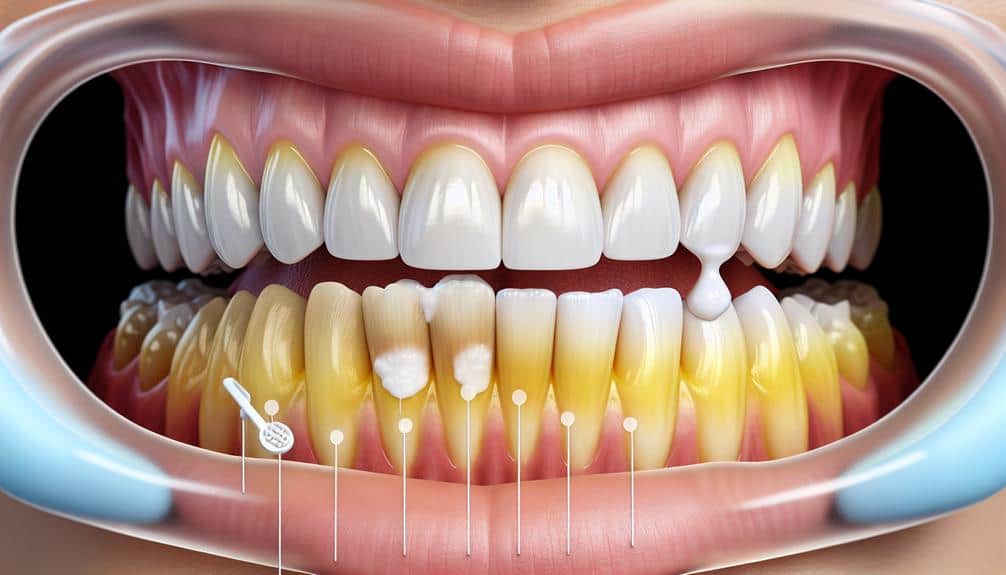To brighten genetic tooth discoloration, consider professional whitening treatments like bleaching or dental veneers. These options are tailored to your specific needs and can provide noticeable results quickly. Home remedies like a baking soda paste or oil pulling with coconut oil can also help. Lifestyle changes, such as avoiding teeth-staining foods and increasing water intake, are beneficial. To maintain lasting results, regular dental check-ups and using whitening toothpaste are essential. Taking a holistic approach combining professional care and home remedies will give you the best chance at a brighter smile.
Key Points
- Consult a dentist for personalized treatment plans based on genetic causes.
- Consider professional whitening options for effective and tailored treatments.
- Use home remedies like baking soda paste or oil pulling for natural brightening.
- Make lifestyle changes to reduce staining and maintain oral health.
- Maintain results with regular dental check-ups, whitening toothpaste, and good oral hygiene.
Understanding Genetic Tooth Discoloration
When exploring genetic tooth discoloration, it's important to understand the underlying causes and mechanisms that contribute to this inherited condition. Genetic causes play a significant role in determining the color of your teeth. Variations in the genes responsible for enamel formation, dentin structure, and tooth development can lead to discoloration that's passed down through generations.
Treatment options for genetic tooth discoloration can vary depending on the severity and underlying cause. Professional whitening treatments may help improve the appearance of discolored teeth, but they may not address the root genetic issue. In some cases, veneers or crowns could be considered to cover the discolored teeth permanently.
It is essential to consult with a dental professional to determine the most suitable treatment plan for your genetic tooth discoloration. They can provide personalized recommendations based on your unique genetic makeup and the specific characteristics of your discoloration. Remember, understanding the genetic causes behind tooth discoloration is the first step towards achieving a brighter smile.
Professional Whitening Options
To enhance the brightness of your teeth affected by genetic discoloration, professional whitening treatments offer effective solutions. Cosmetic dentistry provides a range of options for individuals looking to address tooth discoloration caused by genetic factors.
One of the most common professional whitening techniques used in cosmetic dentistry is bleaching. This process involves the application of a bleaching agent to the teeth to lighten and brighten their appearance.
Professional whitening treatments administered by a qualified dentist can help to greatly reduce the appearance of genetic tooth discoloration. These treatments are tailored to meet individual needs and can provide noticeable results in a relatively short amount of time. Dentists specializing in cosmetic dentistry have the expertise and tools necessary to safely and effectively whiten teeth affected by genetic factors.
Home Remedies for Brightening Teeth
If you're looking for other methods to brighten your teeth beyond professional whitening treatments, exploring home remedies can be a cost-effective and convenient option. Natural remedies and DIY solutions offer a more gentle approach to teeth brightening, utilizing common household items to help you achieve a whiter smile.
Here are three effective home remedies to explore:
- Baking Soda Paste: Create a paste using baking soda and a small amount of water. Gently brush your teeth with this paste for a few minutes, then rinse thoroughly. Baking soda's mild abrasive properties can help remove surface stains.
- Oil Pulling: Swish a tablespoon of coconut oil around in your mouth for about 15-20 minutes. This ancient practice is believed to reduce bacteria in the mouth and improve overall oral health, potentially leading to a brighter smile.
- Strawberries and Baking Soda: Mash up a ripe strawberry and mix it with a pinch of baking soda to form a paste. Apply this mixture to your teeth for 5 minutes before rinsing. Strawberries contain malic acid, which can help whiten teeth naturally.
Lifestyle Changes for Whiter Teeth
Implementing certain lifestyle changes can contribute greatly to achieving whiter teeth naturally. When it comes to diet changes, reducing the intake of foods and beverages that stain teeth, such as coffee, tea, red wine, and berries, can help prevent further discoloration. Opt for teeth-friendly options like crunchy fruits and vegetables that can help scrub away surface stains. Additionally, incorporating more water into your daily routine can help wash away food particles and prevent staining.
Maintaining good oral hygiene habits is vital for achieving and maintaining white teeth. Brush your teeth at least twice a day with a whitening toothpaste to remove surface stains. Floss daily to clean between your teeth and prevent plaque buildup, which can lead to discoloration. Consider using a mouthwash that targets bacteria to keep your mouth healthy and fresh. Regular dental cleanings and check-ups are also essential to address any underlying issues and keep your smile bright. By making these lifestyle changes, you can work towards a brighter, whiter smile naturally.
Maintenance Tips for Lasting Results
Making subtle adjustments to your daily routine can help preserve the results of your efforts in achieving whiter teeth naturally. To maintain the brightness of your genetic tooth discoloration treatment, consider the following tips:
- Consistent Preventive Care: Regular dental check-ups and cleanings are essential to prevent new stains from forming and to address any discoloration at an early stage. Follow your dentist's recommendations for oral hygiene practices diligently.
- Mindful Dietary Choices: Be cautious of food and drinks known to stain teeth, such as coffee, tea, red wine, and berries. Limit their consumption, or if consumed, rinse your mouth with water afterward. Incorporate tooth-friendly foods like crunchy fruits and vegetables that can help naturally clean your teeth.
- Use Whitening Toothpaste: Opt for a whitening toothpaste that's gentle yet effective in maintaining the brightness of your teeth. Brush at least twice a day to remove surface stains and prevent discoloration buildup.
Frequently Asked Questions
Can Genetic Tooth Discoloration Be Completely Reversed With Professional Whitening Treatments?
Professional whitening treatments can notably improve genetic tooth discoloration, but complete reversal may be limited. For long-term maintenance, consider regular touch-ups or at-home maintenance products recommended by your dentist to sustain results.
Are There Any Specific Dietary Recommendations to Help Prevent or Minimize Genetic Tooth Discoloration?
To prevent genetic tooth discoloration, consider dietary habits and lifestyle changes. Incorporate preventive measures and home remedies like reducing intake of staining foods and drinks, maintaining good oral hygiene, and visiting your dentist regularly for cleanings and check-ups.
How Can Genetic Tooth Discoloration Affect Children's Teeth as They Grow and Develop?
As children grow, genetic tooth discoloration can impact pediatric dentistry. Enamel development may be affected, necessitating early orthodontic treatment. Early intervention is vital to address any issues promptly and maintain excellent dental health for your child.
Are There Any Natural Supplements or Vitamins That Can Help Improve Genetic Tooth Discoloration?
To improve genetic tooth discoloration, consider herbal remedies like turmeric or activated charcoal for their potential effectiveness. Lifestyle changes, such as reducing consumption of staining foods, can have a significant impact on brightening your smile naturally.
How Does Genetic Tooth Discoloration Differ From Other Types of Tooth Discoloration Caused by External Factors?
Genetic tooth discoloration differs from other types caused by external factors in that it stems from inherited discoloration causes, rather than environmental factors. Understanding this distinction can guide personalized treatment approaches for addressing genetic tooth discoloration effectively.



